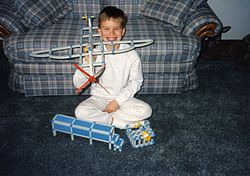- Construx
-
Construx was a brand of plastic building toys introduced by Fisher-Price in 1983. Unlike other building toys such as Lego, Construx featured beam-like pieces of varying lengths that snapped on to cubical connector knots in order to build large shapes. These were relatively secure even though no nuts or bolts were used. Panels allowed assembly of flat surfaces. Hinges, motors, wheels, and other movable parts expanded the number of different shapes that could be built, and made moving creations possible. Construx was discontinued in 1988, briefly revived by Mattel in 1997, and then discontinued again.
The parts included:
- Blue connector knots, all six sides of which can snap on to beams or other pieces. In the Alien series sets, these knots were gray instead of blue. In addition, specialty sets such as military-themed sets, had olive drab knots to go with the dark green connector beams.
- Beams, the other staple part, having lengths of 1, 2, and 4. Notched at each end to accept a "knot" piece, they have a hollow bottom, which is the direction from which knots snap in and out. Originally gray, the Space and Alien series added white and black beams respectively. Military series sets had beams and knots in camouflage green.
- Hinge knots, black in color. Similar to blue connector knots, they have 4 connections, three rigidly connected together, and the fourth, on the other side of the hinge, movable through 180 degrees.
- Spinner knots, orange in color. They have 5 regular points, and 1 special knot acceptor that clicks onto another knot allowing the two pieces to rotate freely with respect to each other. The offset on this connector is a unique distance, limiting the versatility of this piece.
- Orange knots. 5 points again, but with a flat and a small hole on one side. This is meant to hold onto a string for a crane set. You pass a shoelace through the small hole, and double it back through the opposite face of the knot.
- Angle knots, 4 points, made of green plastic, each of the four sides consisted of a point, in the shape of an elongated diamond. They were found in Space kits.
- Diagonal clips, flat straps of blue plastic with end hooks to grab a knot. They are long enough to reach two down/two across. They're the right size to reinforce a corner. They are free to swing from a knot, and can add movement.
- Axles, which could slip through the holes in connector knots, and the hollow of beams. Pulleys can hang off them.
- Bent Bars. These were either 2 down/2 across, or 2 down/4 across. The long ones come in left and right versions.
- Canopy. Available in short and long. They were usually attached to two Bent Bars to form a cockpit. A nice piece for show and imagination, but not structurally significant.
- Panels. Available in 1x2, 2x2, 2x4, and matches for the canopy pieces. Available in blue, space-green, and camo colors. These are usually not structural, but you can use them to keep bars from backing out of their knots by pointing the bar's slot side away from the panel, and attach.
- Wheels and pulleys, crane hooks, winches, seats, men, engine panels, turntables, and more.
For a short time near the end of the Fisher Price run, a version targeted at younger children was released called Basix Construx. It used bright primary colors and did not contain the more complex pieces such as axles and pulleys. This version as well as the other boxes released in the 1997 revival included several new pieces.
- Bent Bars of 1 down/1 across, in smooth curves or 45 degree angles.
- A curved 1x1x1 3D panel, meant to be used with three small bent bars. Not available in Basix.
- Huge panels of 4x8 that instead of just snapping into place actually connect to knots at intervals of 2. Only in Basix.
- Short Beams (1 long) with connector points on two sides, effectively enabling 1/2 connections.
- Four way connector knots, with a hole in the center.
External links

This toy-related article is a stub. You can help Wikipedia by expanding it.


